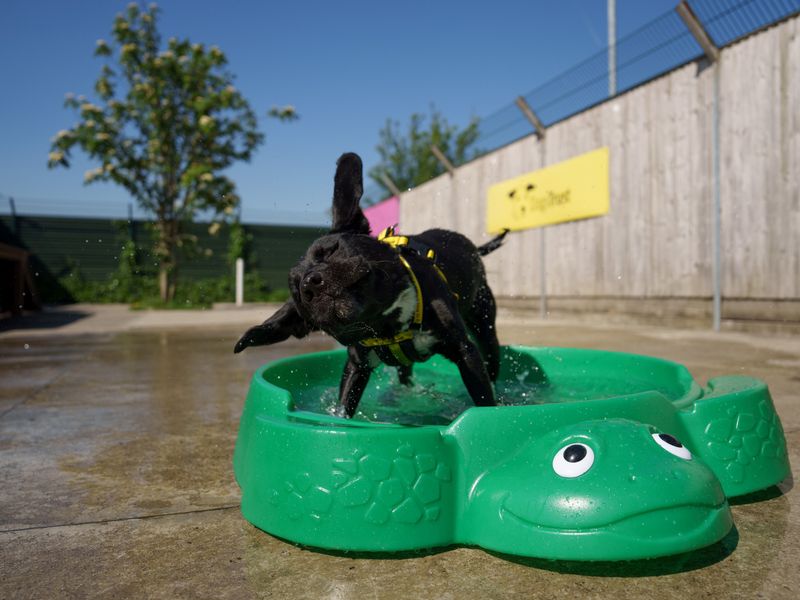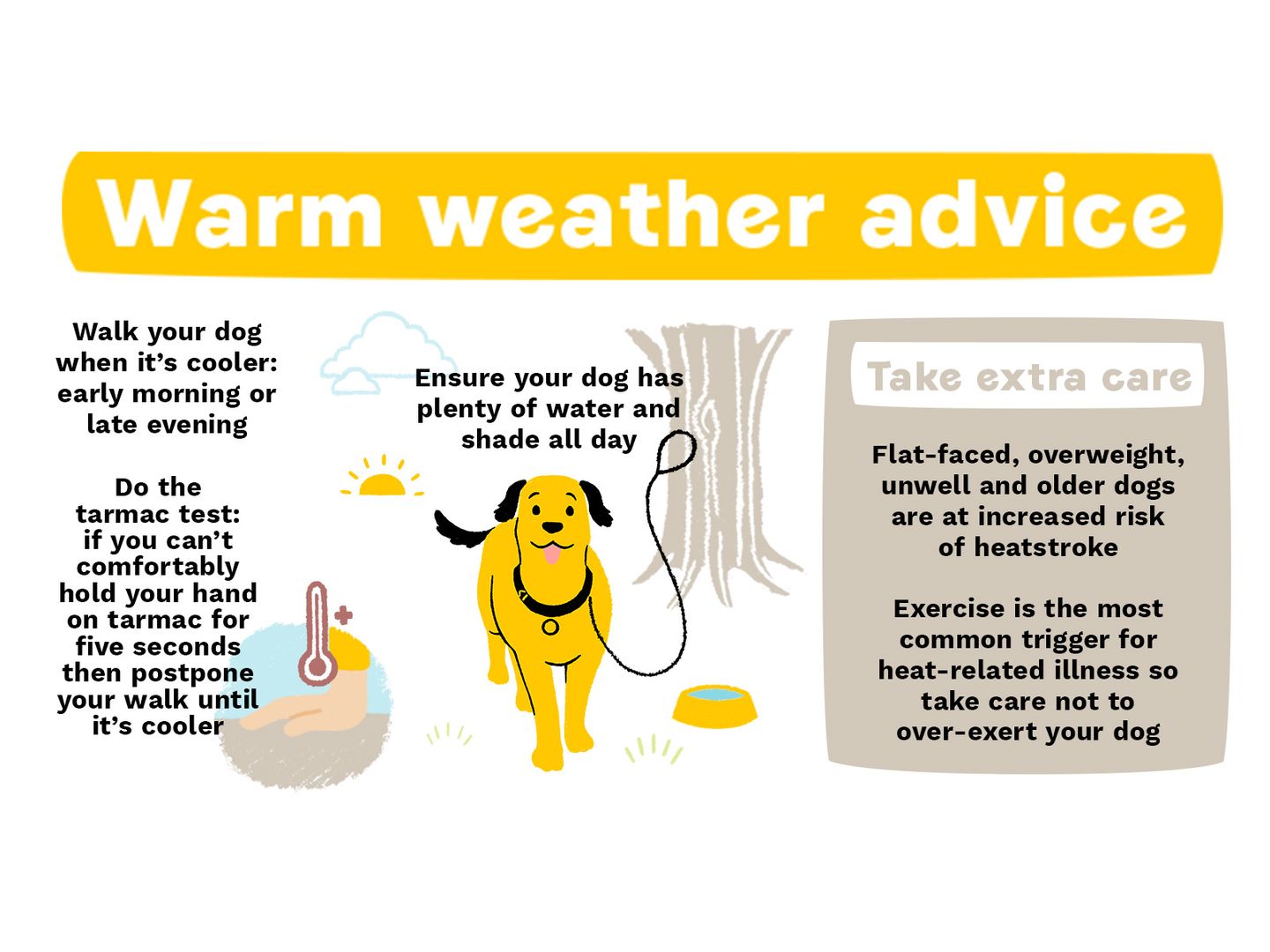Warm weather advice
Keep your dog happy and healthy in warm weather with our tips for safe fun in the sun.

Because our furry friends can’t cool themselves down as effectively as people can, it’s up to us to make sure they stay safe in warmer weather conditions. Heatstroke is a real risk for dogs as they must rely on cooling down by panting or releasing small amounts of heat through their paw pads. When air and ground temperatures are high, this becomes increasingly difficult, and they can quickly overheat.

Top tips for staying safe in hot weather
- Provide shade and water - Make sure your dog has access to shade and plenty of fresh water throughout the day. You can place a damp towel in their shady spot that they can lie on to keep them even cooler. Don’t forget to replace or rewet it regularly though as it can dry out quickly. Never place a damp towel over a dog as it could actually cause their temperature to rise.
- Plan your walkies - Walk your dog in the early morning or late in the evening when temperatures are cooler. This will reduce their risk of heatstroke. Be particularly careful if your dog is old, overweight, suffers from breathing difficulties or is a flat faced breed like Pugs, French Bulldogs or English Bulldogs.
- Familiarise yourself with signs of heatstroke and cooling first aid - The ability to identify if your dog is overheating and knowing how to administer cooling first aid could be lifesaving. Keep reading to learn more about this.
- Do the five-second tarmac test - Tarmac can get very hot in the sun and could burn your dog’s paws. Check the pavement with your hand before letting your dog walk on it – hold your hand down for five seconds, if it's too hot for you, then we recommend walking your dog later when it’s cooled down to avoid burning their paws.
- Don't let your dog get burnt - Keep your dog out of direct sunlight where you can. Use pet-safe sun cream on exposed parts of your dog’s skin, like the tips of their ears and nose. Ask your vet for more advice if needed.
- Check ahead for adventures - If you're planning a day out somewhere, check whether dogs are welcome, always plan for plenty of water and toilet stops too.
- Consider not using the car - Think twice about any car trips with your dog, avoid congested roads or busy times of day when they could overheat in the car if you are caught up in traffic. Avoid long car journeys in hot weather, if you need to travel, avoid the heat of the day and use a car sunblind for shade.
- Book in a trip to the groomers - It can be a good idea to trim back particularly hairy dogs’ fur on consultation with your groomer, so they won’t get so hot.
Looking for a dog friendly recipe to help beat the heat?
Why is overheating dangerous for dogs?
Getting too hot can be really risky for our four-legged friends. They can’t sweat (except through their paws), so they rely on panting as their main way to get rid of heat. Panting is less efficient than sweating, especially when it is humid.
Heat related illness is sometimes called ‘heat stress’, ‘heat exhaustion’ or ‘heatstroke’ - these terms describe increasing severity of heat related illness. You might think it’s only a problem in the summer months or during warm weather, but dogs can overheat at any temperature, and any time of year including during winter. A recent study has shown that a significant number of dogs were diagnosed with heatstroke when the temperature was only 16.9 degrees Celsius.
What are the signs of heat related illness in dogs?
- Heavy or continuous panting, even when they’ve stopped exercise
- It may look like your dog is ‘smiling’ because they pull up the corners of their mouth to pant harder
- Their tongue may be hanging out more
- Their eyes might look ‘squinty’ - Difficulty breathing or changes to their breathing
- Bright pink/ red gums and lips
- Seeming lethargic, drowsy, stiff or unwilling to move
- Shade seeking
- Seeming wobbly or uncoordinated
- Excessive drooling
- Vomiting and diarrhoea
- Collapse
- Seizures
The most common heatstroke symptoms are breathing changes (panting excessively or changes to breathing effort) and lethargy or drowsiness.
Heatstroke in dogs is a serious and sadly sometimes fatal condition for dogs. If you notice any of the above symptoms in your dog it is vital you take quick action.
What should I do if my dog gets too hot?
Act immediately to prevent your dog’s condition getting worse.
It is important to seek immediate veterinary attention as soon as you suspect heatstroke; the sooner this happens, the better chance your dog has of making a full recovery.
- Dial your vet on speaker phone immediately, while moving your dog to a cool or shaded area, lying them down on a wet towel or cooling mat. Don’t cover them with a wet towel, as they dry quickly and this can increase their temperature further. Advise your vet that your dog may be suffering from heatstroke and describe your dog’s symptoms.
- If you are waiting for transport and cannot immediately get your dog to the vet, start pouring small amounts of room temperature (not cold) water onto your dog’s body, avoiding their face, to gently cool their external skin temperature. If they are alert, offer them small amounts of room temperature (never cold) water to help bring their temperature down further. They can also be placed in front of the breeze of a fan if you have one available.
- If you are driving to the vet, the above step can be done in the car, provided you have someone to help you. You can also make an active attempt to cool the car on the way by driving with the windows down or air-conditioning on. This should help to further reduce your dog’s core temperature.
The main goal of treating heatstroke in dogs is to lower their body temperature quickly enough to prevent further damage being done to their vital organs, but not so quickly that the dog goes into shock, or that blood vessels in the skin constrict and blood flow to the area is reduced- both of these scenarios prevent cooling, and this is why the use of very cold water or ice is not recommended. A dog’s temperature should be monitored so that once they reach a normal core temperature, active cooling can be stopped and this should prevent hypothermia (abnormally low body temperature). Dogs that recover are usually those whose temperatures are returned to normal as early as possible. The longer their body temperature stays at a high-level, the greater the potential for damage to their vital organs.
Some dogs are more at risk than others
Heatstroke can affect any type of dog, but certain breeds and types of dogs are at increased risk:
- Brachycephalic or flat-faced breeds such as English Bulldogs, Pugs and French Bulldogs
- Older dogs
- Puppies
- Overweight dogs or those with low fitness levels
- Dogs with underlying health conditions or respiratory or heart diseases
- Larger breeds
- Dogs not used to warm weather
According to research (from the VetCompass Programme at the Royal Veterinary College (RVC) in collaboration with Nottingham Trent University), Bulldogs are fourteen times more likely to suffer heat-related illness compared to Labrador Retrievers.** Over a third of owners of flat-faced dogs reported that heat regulation is a problem for their pet.***
Won’t my dog know when they’ve had enough?
We need to learn the signs of heatstroke and look out for these in our dogs to help them take a rest and cool down when they need to. Some dogs aren’t good at self-regulating and may continue to run and play even though they’re hot and tired, which increases their risk of heatstroke.
Never leave your dog in a vehicle
Never ever leave your dog alone in a car. A dog could die in a hot car in just minutes. Even if the car is parked in the shade and the windows are left down, it does very little to keep the temperature in the car low.
Think twice about and car trips with your dog. If you do have to travel with your dog, plan your journey. Consider travelling at cooler times of the day, identify places to take breaks and avoid congested roads or busy times of day when you could get caught in traffic
What to do if you see a dog in distress in a hot car
If you see a dog alone in a car, first have a look around for the owner. If you cannot see the owner and you are worried the dog may be suffering from heatstroke, contact the local Garda Station and give them details of the situation. Stay with the dog until the Gardaí arrive and once the dog has been safely removed from the car, seek veterinary attention immediately. You can find details of your local Garda Station on their website.
If the situation becomes critical for the dog and the Gardaí are too far away or unable to attend, many people's instinct will be to break into the car to free the dog. If you decide to do this, please be aware, this could be classed as criminal damage and, potentially, you may need to defend your actions in court.
Tips for summer dips
- There are many risks to permitting a dog to swim in water, fetch toys or even just paddling etc – water ingestion, toxic blue-green algae, underwater hazards such as broken glass, fishing hooks that can cause nasty injuries and be difficult to remove etc. If you are unsure, it is best to stay away from water altogether.
- When walking by water it’s important to have a well-practised recall, and food-manners/leave it to be able to call your dog away from tempting distractions like birds and fisherman’s lunches or kids feeding birds with bread etc.
- It therefore might also help to take a harness and longline lead with you so you can ensure control over your dog while still permitting them some freedom to roam a little.
- Some dogs will naturally want to enter water, some might even leap in so you do need to be vigilant and pop your dog on lead if they might jump into water they can’t necessarily easily get out of.
- Never force your dog to enter the water. If you’d like to encourage your dog to paddle and they’re a little unsure, choose a sloping flat ‘beach’ so they can walk in without having to take any ‘leap of faith’ and ideally where the bottom can be seen. Wait next to the water’s edge calmly to see if they take a step towards it or to investigate it, then praise. Let them go at their own pace and if they don’t want to paddle that’s fine – if you let them decide for themselves, they’ll feel safer and of course they need to trust you to be there to help them out and not ever make them feel uncomfortable.
- Another risk with waterside walking is that sometimes you get reeds or water grasses very close to the edge and dogs don’t realise this is water and run onto it then suddenly plunge in.
- Some dogs will enjoy playing with toys in water, and will swim out to fetch these so you need to make sure it’s safe to play like this, and that you have a toy that will float and be visible once floating, plus easy for your dog to hold with their mouth and don’t throw any toys too far.
- It’s important to consider the size and swimming ability of your dog when you are allowing them to get into the water. For example, a fast-moving river might be ok for a larger dog like a Labrador, who is comfortable swimming to enter. However, this might not be suitable for a small dog like a Chihuahua, an older dog, or a dog that is new to swimming.
- Some dogs who suffer with ear infections need to be careful about getting their ears wet, as it can exasperate their issues.
- All dogs should be fully vaccinated when around canals/rivers/lakes as some waterways can be a source of infectious disease.
Blue/Green Algae
Blue/green algae is often seen in hot weather, in non-flowing water but it can be seen at any time of year. Although it’s commonly referred to as an algae in fact, it is actually a group of bacteria that has formed into “clumps”. Blooms of the bacteria can build up at the edges of ponds and lakes, making it look foamy and can often be brown in colour as well as blue or green.
The bacteria produce toxins which can stop a dog’s liver from functioning properly.
Not all types of blue green algae are harmful, but you can’t tell from just looking at them – exposure to toxic algae can result in long term health problems for dogs, or even be fatal.
Symptoms of toxicity include:
- Vomiting
- Diarrhoea
- Seizures
- Weakness, collapse
- Confusion, unconsciousness
- Salivating
- Breathing problems
To reduce the risk of your dog being poisoned, look out for signs from local councils or environmental agencies around bodies of water which may serve as warnings.
Keep your dog on a lead around water which is known or suspected to have blue-green algal blooms, and do not let your dog drink from them, or swim in them.
If your dog has been swimming anywhere outside, it is sensible to rinse them thoroughly with clean water afterwards, as dogs can indirectly ingest the toxins from their coats when they lick themselves afterwards.
If you suspect your dog has been poisoned, seek veterinary attention immediately. There is no antidote for the toxin, but prompt intervention can improve the chances of survival.
Keep cool with summer snacks
Our simple and easy summery treat recipes will help your dog stay cool and will give you fun activity to bond with your dog.



.jpg)